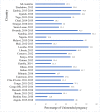Prevalence and determinants of unintended pregnancy in sub-Saharan Africa: A multi-country analysis of demographic and health surveys
- PMID: 31398240
- PMCID: PMC6688809
- DOI: 10.1371/journal.pone.0220970
Prevalence and determinants of unintended pregnancy in sub-Saharan Africa: A multi-country analysis of demographic and health surveys
Abstract
Introduction: Approximately 14 million unintended pregnancies are recorded annually in sub-Saharan Africa (SSA). We sought to investigate the prevalence and determinants of unintended pregnancies among women in sub-Saharan Africa.
Materials and methods: The study pooled data from current Demographic and Health Surveys (DHS) conducted from January 1, 2010 to December 31, 2016 from 29 countries in SSA. Logistic regression analysis was used to examine the factors that influence unintended pregnancies in SSA. Results were presented using odds ratios (OR).
Results: We found overall unintended pregnancy prevalence rate of 29%, ranging from 10.8% in Nigeria to 54.5% in Namibia. As compared to women aged 15-19 years, women of all other age categories had higher odds of unintended pregnancies. Married women were 6 times more probable to report unintended pregnancy as compared to women who had never married (OR = 6.29, CI = 5.65-7.01). The phenomenon had higher odds among rural residents as compared to urban residents (OR = 1.08, CI = 1.01-1.16). Women with primary (OR = 0.74, CI = 0.69-0.80) and secondary (OR = 0.71, CI = 0.65-0.77) levels of education had less chances of unintended pregnancies, compared to those with no education. Again, women in all other wealth categories had less probability of unintended pregnancy, as compared to women with poorest wealth status.
Conclusion: Our study contributes substantially towards the discourse of maternal wellbeing by unveiling the prevalence and determinants of unintended pregnancy across the SSA region. There is the need for SSA countries with high prevalence of unintended pregnancies to consider past and present successful interventions of other countries within the region such as health education, counselling, skills-building, comprehensive sex education and access to contraception. Much of these efforts rest with the governments of SSA countries.
Conflict of interest statement
The authors have declared that no competing interests exist.
Figures
References
-
- Amin SF, Howden CP, Peyman N. Comparison study: risk factors of unplanned pregnancies in a Group of Iranian and New Zealander Women. J Eur J Sci Res. 2009; 26(1):108–121.
-
- Centers for Disease Control and Prevention [CDC]. Unintended pregnancy prevention; 2015 [cited 2019 March 14] Available from https://www.cdc.gov/reproductivehealth/unintendedpregnancy/.
-
- Singh S, Sedgh G, Hussain R. Unintended pregnancy: worldwide levels, trends, and outcomes. Studies in Family Planning. 2010;41(4):241–250. - PubMed
MeSH terms
LinkOut - more resources
Full Text Sources
Research Materials
Miscellaneous


